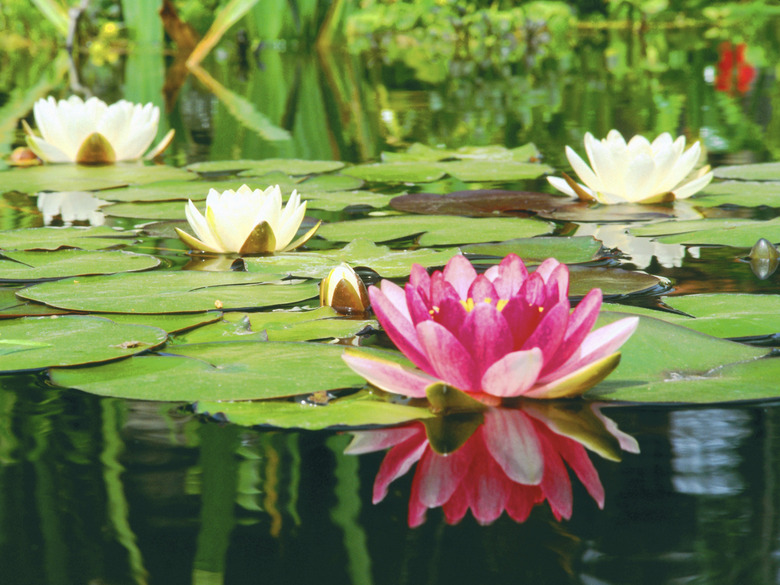What Is Needed To Kill Lily Pads In Fish Ponds?
Lily pads are a natural element in most ponds. They help to oxygenate water, offer cover for aquatic life and support amphibian lifeforms. However, when lily pads overtake the surface of a pond, they use up oxygen needed for other pond life, including fish. If you have a fish pond, be sure lily pads cover only 30 percent to 50 percent of the surface.
Rake
If you want to kill lily pads without harming fish and other wildlife, Texas Parks and Wildlife Department aquatic vegetation biologist Howard Elder suggests you rake out what you can. Lake rakes, which are longer than a yard rake, allow you to remove lily pads without wading into the pond. Such rakes are available at many sports and outdoors stores as well as department stores.
- Lily pads are a natural element in most ponds.
- If you want to kill lily pads without harming fish and other wildlife, Texas Parks and Wildlife Department aquatic vegetation biologist Howard Elder suggests you rake out what you can.
Chemical Solutions
Many pond owners turn to products containing glyphosate, which include Shore-Klear and Aquastar, both of which are registered with the Environmental Protection Agency. Such products can be mixed with detergent and applied to lily pads with a sprayer for spot treatment. Spray carefully to avoid the chance of decomposing plants passing chemical gasses onto remaining plants. Spray portions of the pond, waiting one week between each section, and rake off dead vegetation each time.
Grass Carp
Young grass carp, which feed on aquatic plants, can help control the spread of lily pads in a pond. Introduce three grass carp per acre in your pond. Because younger carp eat more than older carp, be sure to add young carp each year until they begin to repopulate on their own.
- Many pond owners turn to products containing glyphosate, which include Shore-Klear and Aquastar, both of which are registered with the Environmental Protection Agency.
Professional Help
When all else fails, or when you don't have time to tend to your own fish pond, consider hiring a pond management company. Be sure to hire a certified company.
Facts About Lily Pads
If you've ever encountered a body of water populated with lily pads, you've likely been amazed at how these unusual aquatic plants seem to float on top of the water. There are about 70 different species of this aquatic flowering plant, found in both temperate and tropical zones. Though lily pads appear as if they are simply floating atop the water, they are actually attached to a stem that may extend many feet down to the bottom of a pond or lake, where the plant is rooted. A system of stems and tubes run underneath the lily pad. This oxygen is transferred to the water lily's stem and down to the plant's roots. The bottoms of lily pads may also be a dark purple color in sharp contrast to the green tip surface—this dark coloration helps the leaves absorb the sunlight required for photosynthesis. Water lilies and their surface lily pads can blanket areas of water as deep as six feet. When spread to non-native habitats, water lilies can shade the water and make it too cold for native species of fish and plants. When mashed, the roots created a poultice that reduced swelling.
- When all else fails, or when you don't have time to tend to your own fish pond, consider hiring a pond management company.
- Though lily pads appear as if they are simply floating atop the water, they are actually attached to a stem that may extend many feet down to the bottom of a pond or lake, where the plant is rooted.
References
- Chron: How do I Kill Lily Pads, Not Wildlife?
- Ecy: Aquatic Plant Management
- State of Washington Department of Ecology: Fragrant Water Lily
- Sciencing: Water Lily Adaptations
- The Ohio State University Extension: Benefits and Disadvantages of Aquatic Plants in Ponds
- Vermont Center for Ecostudies: A Water Lily's World
